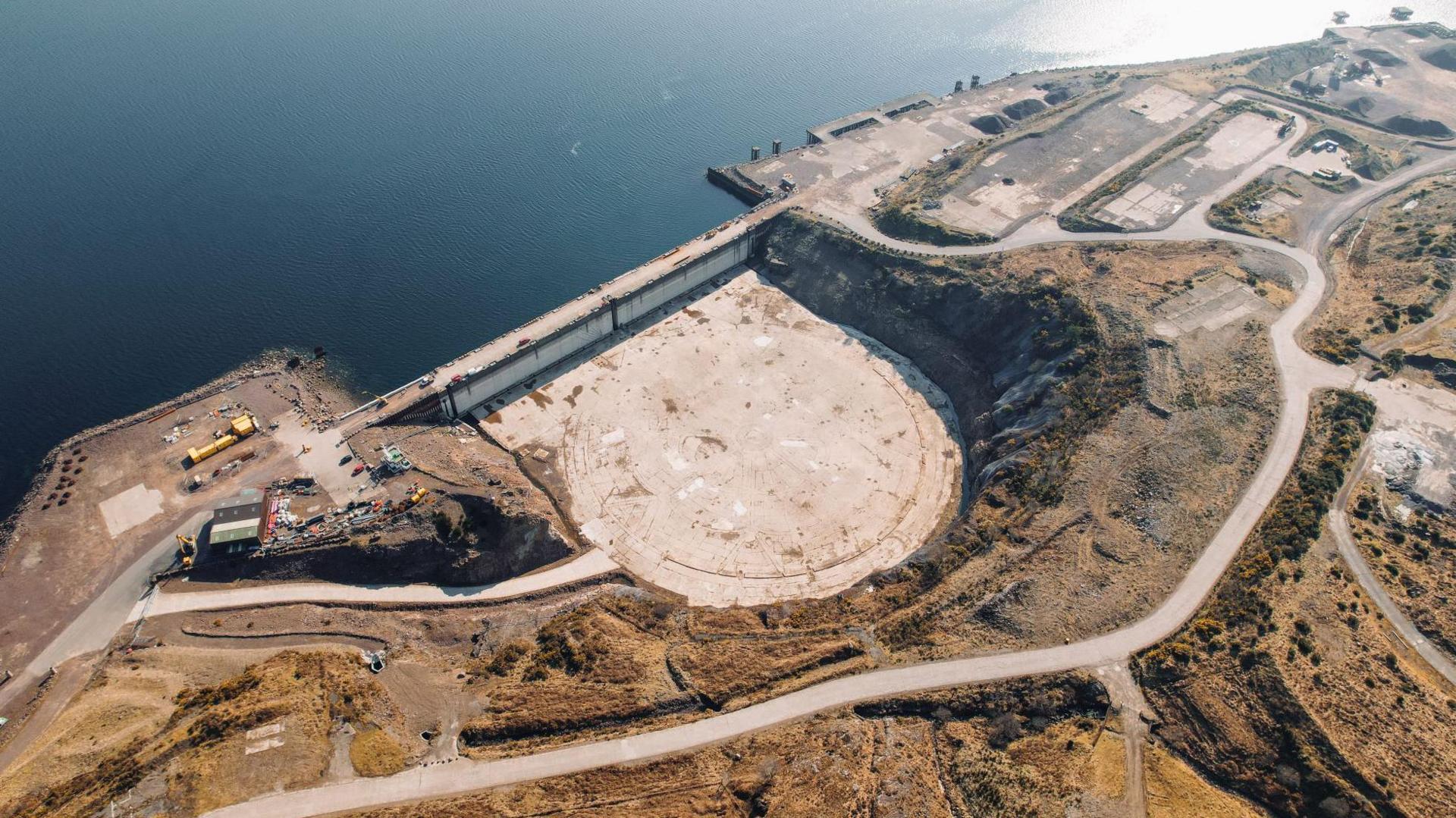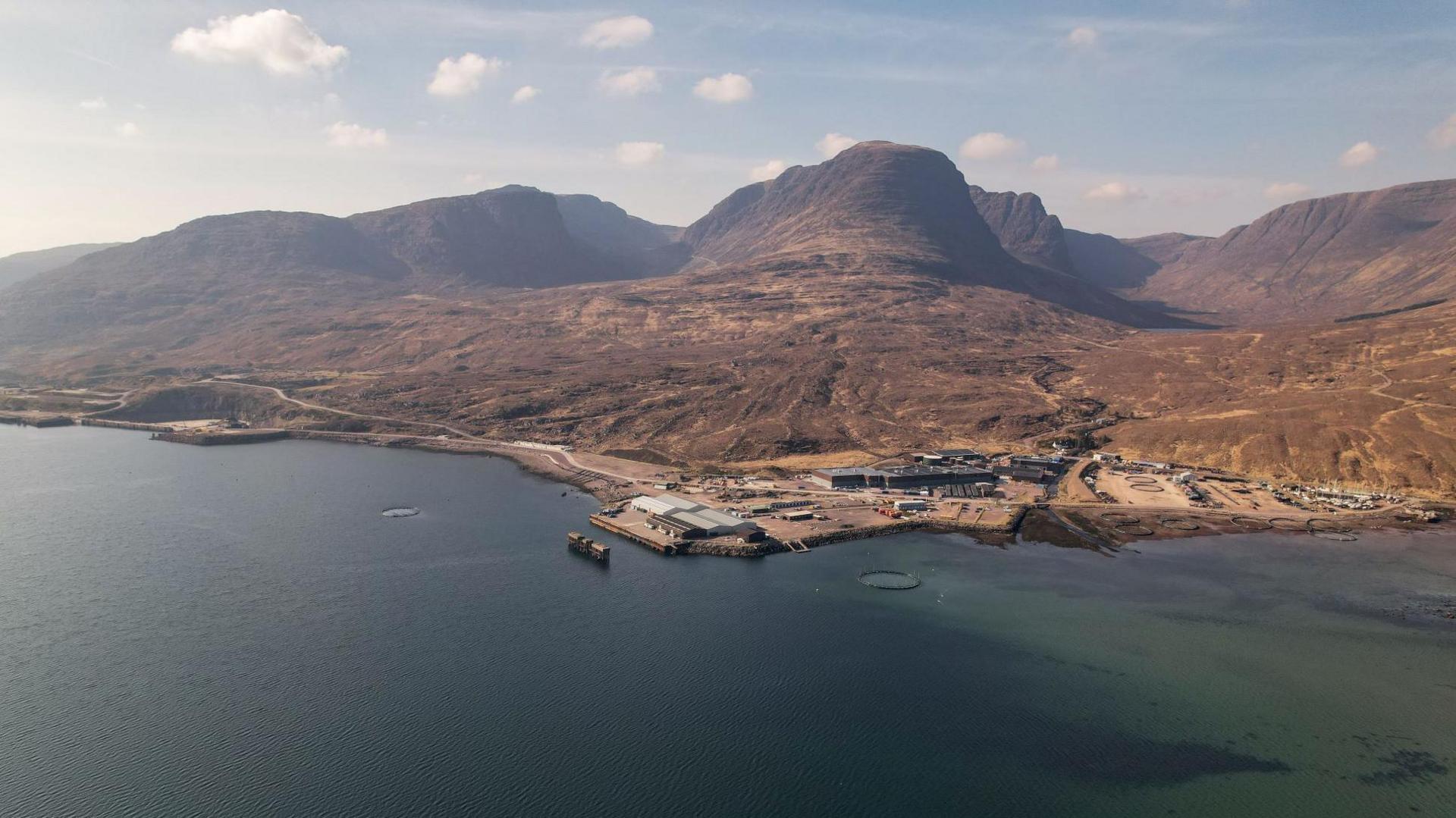Up to £24m to be invested in west Highland port

Kishorn Port's dry dock is to be expanded
- Published
Up to £24m of public money is to be invested in a port on the west Highland coast.
Kishorn was used in the 1970s for the construction of the Ninian Central oil production platform - at the time the world's largest floating concrete structure.
Highlands and Islands Enterprise (HIE) said its investment would enhance the port's capacity for manufacturing floating offshore wind turbine foundations.
Kishorn's dry dock, along with other facilities, are to be expanded.
HIE said there was potential for the port to support up to 1,500 jobs once the expansion was completed.
The investment forms part a Scottish government commitment of up to £500m over five years to develop ports and offshore wind energy supply chain.
Deputy First Minister Kate Forbes described the funding for Kishorn as "significant".
She added: "It is crucial to ensuring Kishorn Port and the communities it supports can reap the benefits of the global renewables market."
HIE chief executive Stuart Black said the site had provided skilled jobs in a rural area for decades.
Kishorn Port Limited (KPL) director Alasdair Ferguson added: "The port expansion will provide the catalyst for the support and creation of jobs within Wester Ross and the wider Highlands, benefiting communities across the area.
"We're grateful to Highlands and Islands Enterprise and Scottish government for their support."

The port is in an area of Wester Ross that is home to roughly 1,000 people.
Between 1975 and 1987, the site was a fabrication yard owned by Howard Doris Ltd and in 1977 more than 3,000 people were employed there.
There was not enough accommodation for so many workers in this part of the north-west Highlands coast so two retired cruise ships, Rangatira and the Odysseus, were brought in to accommodate them.
The yard was used in the construction of the North Sea oil and gas industry's massive Ninian Central Platform in the late 1970s.
This structure weighed 600,000 tonnes once completed, making it the largest manufactured moveable object at the time.
Seven tugs were required to tow it from Loch Kishorn to its North Sea site.

Donald MacDonald worked as a passenger boat skipper at the yard
Donald MacDonald worked at Kishorn when Ninian Central was being built.
He told BBC Naidheachdan: "I was a skipper on a passenger boat, and we were shifting 1,500 workers a shift.
"Anyone who wanted a job could get a job.
The money was good, and some people were getting big bonuses."
Mr Macdonald said he was hopeful the redeveloped yard would bring new job opportunities.
He said: "There are not a lot of long-term jobs on the west coast."

Kishorn employed 3,000 people in 1977

The port is in a sparsely populated area of Wester Ross
The dry dock was used in the 1990s for the making of two concrete caissons - foundations used for deep water or soft ground - to support the Skye Bridge.
The yard was mothballed until 2013 when work started on redeveloping it as a port for supporting the offshore renewable energy sector.
In 2019, Kishorn was used for servicing the world's biggest semi-submersible offshore drilling rig, Ocean GreatWhite.
The 60,800-tonne rig was towed to the Highlands from Singapore via Las Palmas in the Canaries.
Watch: Decommissioned oil rig blown up at Highland port (there is no sound on this video)
Last year, a decommissioned oil rig was destroyed in a controlled explosion in the dry dock.
The Northern Producer had been used in the Dons oil fields about 100 miles (161km) north-east of Shetland.
After it was blown up, various parts of the rig were recycled.

The fabrication yard at Loch Kishorn is one of several sites that saw vast structures built for the oil and gas sector in the 1970s and 1980s, which are now being re-positioned for a big future in offshore wind power.
In the Cromarty Firth, Nigg has already been serving as a base for assembling and shipping out wind turbines.
Invergordon is receiving £55m of UK government funds to prepare for expansion of floating turbines.
At Ardersier, near Inverness Airport, the owner has secured £400m in investment to ready it for activity, with a lot of land available for manufacturing.
There is quayside preparation at Scapa Flow in Orkney.
At Aberdeen's new south harbour, there are big plans as a shore base for loading out equipment. Montrose is developing capacity as well.
In common with the Cromarty Firth and Inverness, the Firth of Forth has "green freeport" status, with incentives to locate business around its shoreline. Leith docks have seen extensive site clearance and a new quayside built.
Under new Spanish ownership, the yard at Methil in Fife and at Arnish on the Isle of Lewis are also well positioned for some of this work.
There will be competition for offshore wind contracts, but the scale of what is planned is so large that there should be work for everyone, at least in providing a shore base for assembly and loading out.
The bigger challenge is in attracting manufacturers to make the offshore wind industry's equipment in Scotland and, if successful, to ensure there are enough skilled workers.